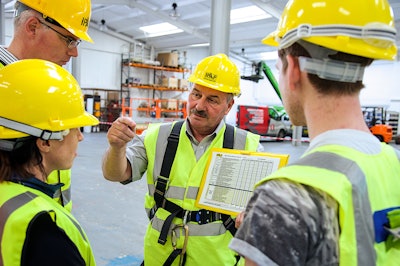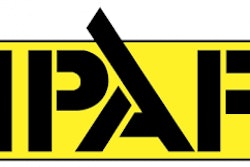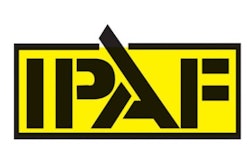
Most everyone working in equipment rental these days has likely heard that ANSI A92 standards for mobile elevating work platforms (MEWPs) go into effect this December. Significantly fewer, however, have a solid handle on what this means to their business, their employees and their customers. We’re here to help.
To start with, in the case of ANSI standards language, rental houses are considered “dealers.” In addition to being a “dealer,” they equally hold the responsibilities of a “user.” A “user” refers to any entity who authorizes and directs operators in the use of MEWPs.
All user responsibilities in the updated A92 safe use and training standards apply to you, the rental house. Whenever a dealer directs personnel to operate a MEWP (loading, unloading, inspecting, sales demonstrations, or any form of use), the dealer shall assume the responsibilities of users.
All user responsibilities in the updated A92 safe use and training standards applies to you, the rental house. Whenever a dealer directs personnel to operate a MEWP (loading, unloading, inspecting, sales demonstrations, or any form of use), the dealer shall assume the responsibilities of users.
“Rental companies need to read and fully understand the updated standards in order to comply internally and additionally, to be able to fully assist their customers to meet their responsibilities,” says Tony Groat, IPAF North America manager. “If they can’t get things straight in their own house, so to speak, they can’t possibly help customers to do so.”
He continues, “The rental company is the leader of the band. If they’re off key, the rest of the band will be off key too. In other words, if they’re not doing things correctly, they’ll be showing everyone else the wrong way.”
Despite not being typical “users” of equipment, rental houses do have employees who operate MEWPs – mechanics and sales people, for example - within the facility and on jobsites with delivery and service. As such, they’re responsible for safe use and operation, the same as other users.
“Rental employees need to be trained and someone needs to oversee them,” explains Groat. “They’re obligated, just like all other users, to have a MEWP safe-use plan and to evaluate operator proficiency on an ongoing basis.”
What is ANSI anyway?
ANSI stands for the American National Standards Institute. It’s not a governing body and does not make or enforce laws. ANSI is an organization that coordinates the U.S. voluntary consensus standards system, providing a neutral forum for the development and conformity of policies and assessment programs and processes. In other words, ANSI cannot fine you for not following its standards, but it does advise OSHA on its regulations, which are enforced with fines for violations.
In short, it’s in everyone’s best interest to follow ANSI standards not only because they foster worker and environmental safety, but also because failing to do so could violate OSHA regulations and result in fines.
For its part, the International Powered Access Federation (IPAF) aims to foster the safe use of MEWPs by providing information and training to owners and users. While the organization has no authority to create or enforce standards, it does support their intention and works toward publicizing information so users have maximum comprehension and understanding of what’s required for the safest possible use of the equipment.
“The very first thing every user must do is read and understand the new standards,” says Groat. “On one hand the standard does not introduce many new requirements, but on the opposing hand the standard has added much more detail to ensure users are being as thorough as prior standards expected them to be.”
Ultimately, the goal of the updated standards is to get everyone on the same page to ensure the safe use of equipment. This refers to the application, inspection, training, maintenance, repair and safe operation of MEWPs. Following are some of the basics to keep in mind.
Training and familiarization?
Rental houses should by now be aware that current ANSI standards say they’re obligated to provide equipment familiarization to customers. Specifically, the rental house (dealer), upon delivering a piece of equipment, must be prepared to show the customer the control functions and safety devices for that particular piece of equipment. In addition, if a customer requests training, the rental house is obligated to offer it themselves or refer customers to a reasonable alternative source for the training.
“The classic challenge with existing training and familiarization standards is the statement that rental companies must offer training and provide familiarization, often upon delivery on the jobsite,” Groat says. “But in reality, sometimes deliveries are made after hours when no one is there to receive the equipment, or the person receiving the equipment is not the operator.”
He continues, “The new standards say rental houses are now obligated to offer both training and familiarization. It’s up to the customer to determine if they need either and request it. However, it’s important to be aware not all customers renting equipment even know to ask for familiarization or training, so it’s vital that rental houses make a point of offering it. It’s their responsibility to make their customers aware of the need.”
According to the updated standards, once an operator completes training, the user can determine if they’re qualified to perform the work and then authorize them to operate the MEWP. The operator must periodically demonstrate continued proficiency with the equipment. This can be determined by a designated qualified supervisor who is responsible for monitoring, supervising, evaluating and documenting operators on a regular basis. This person should use reasonable judgment and determine proficiency based on performance. Operators showing diminished performance should be retrained as needed.
The standards define a supervisor as one who is assigned by the user to monitor operator performance and supervise their work, and who is required to complete specific training requirements defined in A92.24 7.5 Supervisor Training, such as IPAF’s MEWPs for Manager’s course.
Assess risk
One of the primary responsibilities of the user is to perform a site risk assessment before each use in order to identify hazards, evaluate risk, develop control measures and communicate them with those affected. No matter how simple or complex the task is, if a MEWP is being operated, the user is responsible for the safety of the person operating the equipment and for bystanders as well.
Once the user has assessed the site for potential hazards, which range from overhead obstructions to soft ground to current wind and weather conditions, they must also continuously revisit the site to determine if new hazards exist. Any changes must then be documented and promptly communicated to everyone involved.
“Once jobsite hazards and risks have been identified, they must be eliminated or mitigated and the plan effectively communicated to all affected parties,” Groat explains. “This is nothing new, of course, a site risk assessment has always been needed, but typically hasn’t been performed as intended. Prior language stated “the standard must be supplemented by good job management, safety control, and the application of sound principles of safety.” Starting this December, a risk assessment will specifically be required as defined in the standard, so users will clearly understand their responsibility.”
Ready to rescue
Rescue planning is another vital part of safe MEWP use and is a necessary component of a site risk assessment. Under the new ANSI standards, users are required to develop a written rescue plan that will be carried out in case of a machine breakdown, platform entanglement or fall from platform. The written plan must be part of the company’s training manual and everyone must receive training that explains the procedures to follow in case of emergency.
Specifics on how to develop a compliant rescue plan can be found at A92.22 Section 6.1.2.6 Rescue from Height
Make the right choice
Once the site has been assessed, the next step is making adjustments as needed to ensure optimum safety, and an important part of that is selecting and providing the right equipment for the job. There are many varieties of powered access equipment, but each has applications it’s uniquely designed for. For optimum safety, choose the right lift for the job at hand; do not simply make do.
Beware of design changes
While only MEWP manufacturers are required to read the revised design standard, it will have an impact on MEWP users. One of the new requirements in the design standard is a requirement for platform load sensing on most MEWPs. This system will identify when the platform rated load is exceeded, sound an alarm and prevent normal movement. This will assist in preventing overloading and minimize the risk of overturning and machine damage. The design standard introduces many new requirements that will enhance MEWP safe operations.
MEWPs manufactured after December must comply with the requirements of the A92.20 Design Standard. MEWPs manufactured to the existing standards do not require changes to meet the new standard. Rental houses renting new equipment that meets the new standards should note the load sensing capability of the machines to customers, especially those with experience renting MEWPs, what this changes means to operation. This will reduce confusion and needless calls for service and hopefully ensure a more satisfactory rental experience for the customer.




















